How to choose plants for shade – for year round garden success
If you’re buying plants for shade, firstly think about what kind of shade you have in your garden.
At least half your garden – wherever you live – is shady. If you’re in a town or city, with a small garden surrounded by tall buildings, then much of your garden may be shady for most of the day. But there are so many beautiful plants that will do well in those conditions!
So I’ve asked top plant expert, Stephen Ryan, who runs the Horti-Culturalists YouTube channel near Melbourne in Australia with his gardening partner, Matthew Lucas for their tips on choosing plants for shade.
Melbourne’s climate is similar to that of the UK in winter, although hotter in summer. Like the UK, Melbourne roughly equates to a US hardiness zone of 9 – although UK summers are cooler. And whether you’re in the UK, the US or Southern Australia, we all grow many of the same plants.
And their autumn is our spring. So the Horti-Culturalists’s video will pick out some good late summer/autumn plants for shade, while the Middlesized Garden’s video talks about shade-loving plants for spring and early summer.
What kind of shade do you have?
Stephen identified four different kinds of shady border. I have all four in my garden. You probably do, too.
And shady borders can be surprisingly low maintenance, as well as pretty.
Firstly, there is the obvious ‘shady border’. It will be north-facing in the Northern hemisphere and south-facing in the Southern hemisphere. It will always be in shade for much of the day, because the fence or hedge behind it will cast shade. If it’s fairly open, then there’ll be up to around three hours at midday when it will get direct sun. But if you have trees or buildings near it, then even that may be cut short.
When choosing plants for this border, be aware of how much direct sun it gets. My shady corner has unusually high walls, so, although it is open it doesn’t get more than the three hours direct sun a day.
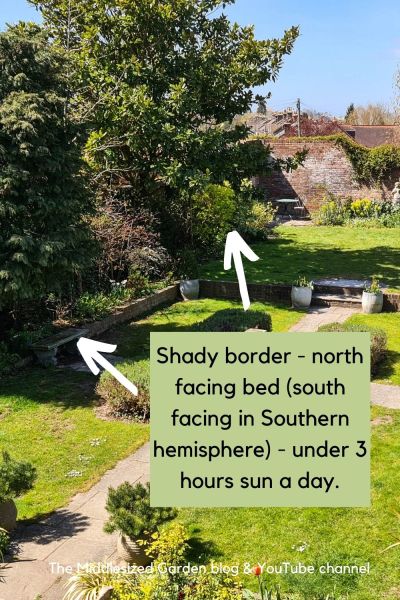
When a border faces North (or south in the Southern hemisphere) and has a wall, fence or hedge behind it, plants will only get around sunshine for around 3 hours a day, when the sun is relatively overhead.
One of the most popular posts we published in the last year was this one on North-facing garden tips, especially as the garden itself was also very narrow. But it shows you how you don’t need lots of space and sun to have a beautiful garden.
And there’s dappled shade, semi-shade and light shade
These terms all mean much the same thing. You get three to six hours of direct sun on your border each day. This may be because the border faces East or West, or there are trees or buildings that partially obscure the sunshine at certain times of day.
I have a beautiful tree growing in a sunny corner of my garden. It throws dappled shade over the border, but some sunshine comes through. This tree – a Robinia frisia – has a great presence in the garden and it is protected by law.
So I am not allowed to cut it down, nor would I wish to. However, I’ve increased the amount of sunshine available to plants below by taking away some of the lower branches. The tree is perfectly proportioned and its canopy is also quite light.
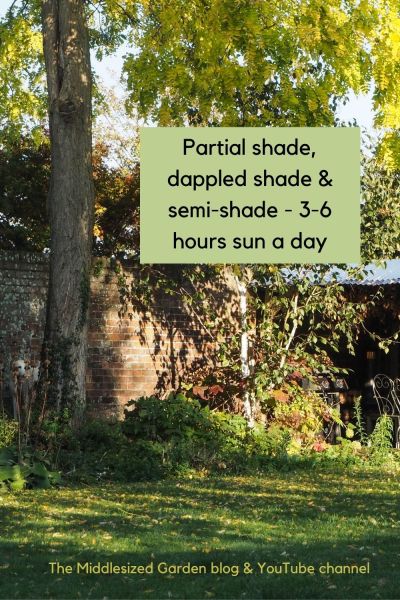
Any area that gets 3-6 hours sun a day has partial shade, dappled shade or semi-shade. I made this corner more sunny by removing the lower branches of the tree.
When choosing plants for light shade, you have more options. It can even be worth experimenting with plants that require ‘full sun’ to see how they grow with you, although if they get leggy or never seem to get going properly, you’ll have to move them.
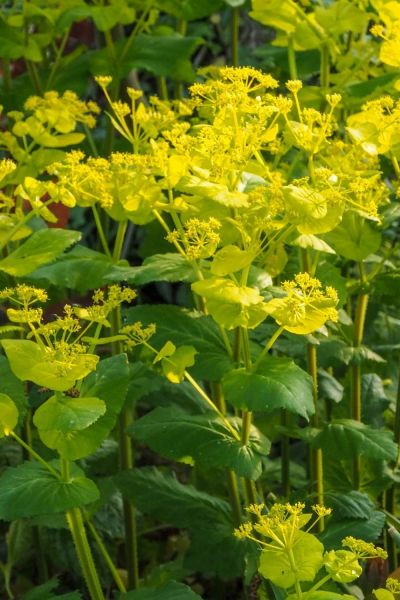
Smyrnium perfoliatum is one of my favourite plants for shade in my partial shade border, flowering in late spring and early summer, then disappearing after that. It’s a biennial so it doesn’t flower its first year, but it self seeds prolifically, so it is easy to grow.
Or seasonal shade
If you have deciduous trees in your border, they will lose their leaves in autumn. They often won’t be fully ‘clothed’ again until late spring or early summer. So this will be a shady border in summer but sunny in spring.
This means that you can pick sun-loving spring plants, such as tulips, daffodils and other bulbs. By the time the border is fully shady again, they will have stored the nutrients they need for flowers next year.
My favourite part of my garden in spring is between a silver birch a cotinus, an amelanchier and an ornamental plum. All lose their leaves in winter, so this area is a riot of bulb colour in spring.
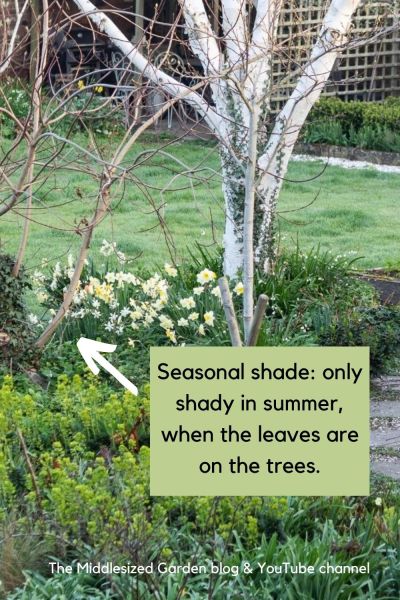
This area is brilliant for bulbs in spring. They go underground in summer, when the leaves are on the trees and it is shady.
You might wonder why I don’t cut these trees down, so I could have this as a sunny border all year round?
Firstly, the biggest – the silver birch – is protected by law. But, secondly, they add height, proportion and architectural interest to the garden. The amelanchier and ornamental plum have stunning blossom in spring and all four trees have outstanding autumn colour. And the white bark of the silver birch is a key winter statement in the garden.
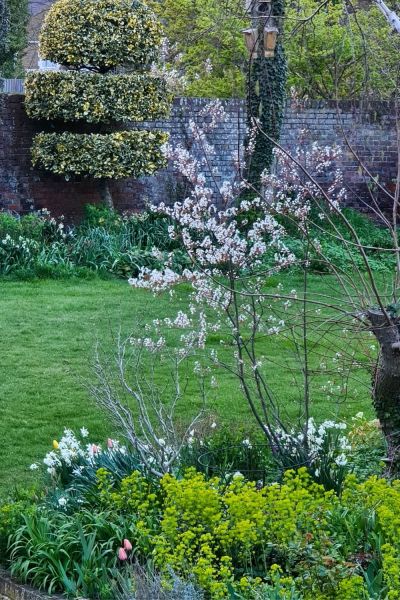
Spring blossom on the Amelanchier lamarkii (Juneberry, Serviceberry), with the bulbs beneath that grow well in this spot even though it is shady in summer.
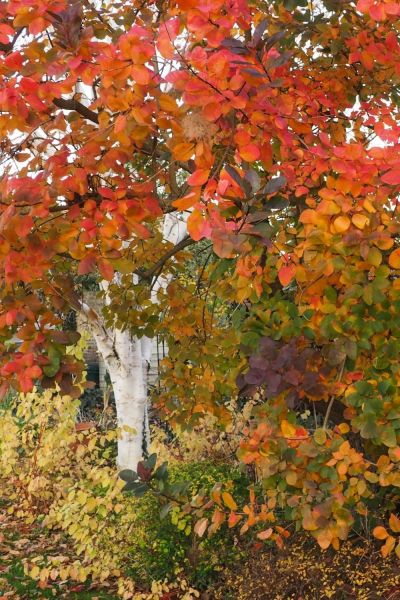
Just a small taste of the autumn colour the four trees give the garden at the end of the season.
They add more colour and drama to the garden throughout the year as trees than a low-growing flower bed would.
In fact, if you have a north-facing border with a 2 metre hedge or fence, then the most effective way to add colour and structure is often to add a deciduous tree with spring blossom and autumn colour. Once the tree is higher than the fence or hedge, it will get all round sun.
And finally – borders with deep shade
If you’re buying plants for shade, this is the only really difficult part of your garden. This border will be north-facing (in the Northern hemisphere, south-facing in Australia/New Zealand). But it will also have buildings or evergreen trees nearby (or both!) so it gets little or no direct sun.
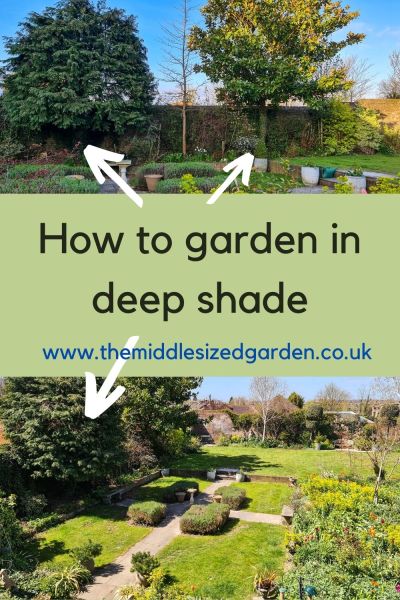
If you have a shady border plus evergreen trees, there will be small patches where very little will grow. But these evergreen trees add year-round structure to the garden, offer shelter to wildlife and screen us from an unsightly street lamp. So I can live with a few bare patches beneath them!
There is a very limited palette of plants that can deal with deep shade, says Stephen. Butcher’s-room (Ruscus aculeatus) is one of the few. It has spiky leaves, small pale green flowers in spring and red berries in autumn (on female plants only, so check).
You can adapt planting advice from woodland gardens. I recently spoke to Lucy Adams, head gardener at Doddington Place Gardens about how to create a woodland garden. One good tip is to plant on the edge of the tree’s canopy, because that will get much more sun.

Plants grow well just under the edge of the trees’ canopy in my garden. You’ll still have to choose plants for shade, but you’ll have a good choice.
It’s hugely helpful to see if weeds grow in your area of deep shade. I have a north-facing border, which is in the shade of the next door building and also has two evergreen trees. Not even weeds grow directly under the conifer, although at the edge of its canopy I can grow snowdrops, ivy and a fern.
If weeds won’t grow there, then there’s not much chance of flowers doing well. You could try growing pots elsewhere and moving them into the deep shade when in flower, but that is a faff. It’s probably better to use the space for something else, such as a shady seating area or bench.
The other tree on my shady border is an evergreen magnolia. But plants do seem to grow under that and on its canopy edge. Its canopy is higher, as we removed some lower branches, so that let’s in a little more light.
There is an Osmanthus delavyi, some saxifrage ‘London Pride’, lily of the valley, two hydrangeas and a somewhat unattractive wild strawberry.
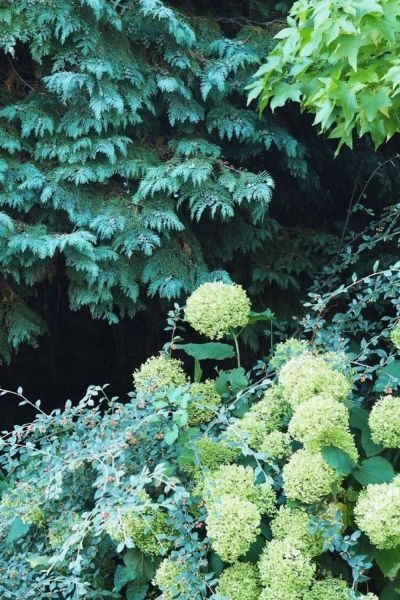
Hydrangea arborescens ‘Annabelle’ grows right up against the conifer in my most shady border. However nothing grows directly under the conifer.
Think about seasonal interest
Once you’ve identified the type of shade you’re planting up, think about seasonal interest. You want a spread of plants that look good in spring, summer, autumn and even winter. Many online plant sellers will have a ‘plants for shade’ option on their websites, so it’s relatively easy to find plants.
To give you inspiration, I’ll start off with some of the shade-loving plants that have been most successful for me in the first half of the season. Stephen and Matthew will suggest some late summer/autumn plants over on The Horti-Culturalists.
Plants for shade in late winter/early spring
Snowdrops grow very well under deciduous trees. They’re woodland bulbs, so they’re a natural for growing under trees which lose their leaves in winter and also for canopy edge of evergreen trees.
In terms of deciduous shrubs, then winter hazel (Corylopsis pauciflora) has delicate yellow flowers.
And mahonia is a brilliant large evergreen shrub with a sculptural outline and bright yellow flowers. It can take quite deep shade. Mahonia has fallen out of favour over the past few decades because it is a favourite of town car parks, where it gets butchered by people with chain saws. But properly pruned (or even just left to itself), it has beautifully dark glossy leaves and a showy display of flowers. Overdue for a revival.

Mahonia, with its sculptural leaves and bright yellow flowers, seen here in the woodland garden at Doddington Place Gardens. A very easy, striking shrub for shady borders.
If you’re looking for good shade-loving spring perennials, Bergenia is the easiest plant I have ever grown. I very rarely pay it any attention. Yet it reliably flowers every year for weeks, in clumps beside walls, under deciduous trees and in neglected corners.
And what would spring be without hellebores? People can become obsessed with hellebores, but they are still very easy-care. I have some on the canopy edge of my deep shade border, plus some more in the partial shade bed. They’re very resilient for such delicate-looking plants.
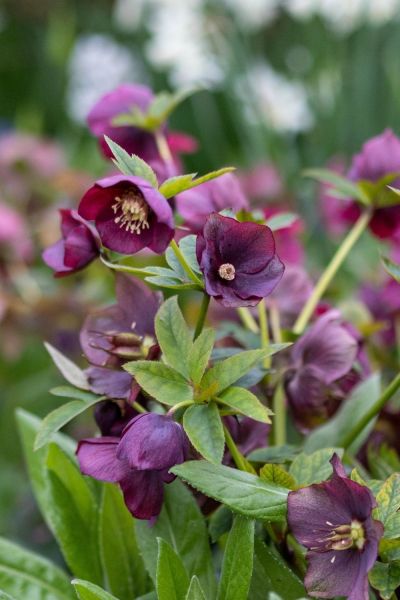
Hellebores are easy-care plants for shade.
Perennial plants for shade in late spring and early summer
There are so many choices! Mediterranean spurge of (Euphorbia characias ‘Wulfenii’) is a star in the shadier parts of my garden throughout spring. It spreads, but isn’t too invasive, so I find it very easy care.
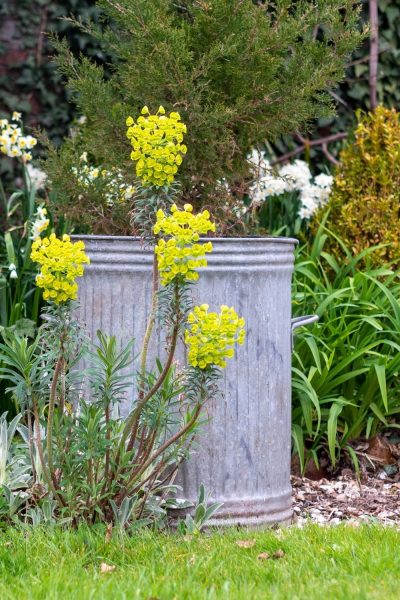
Euphorbia ‘Wulfenii’ is an easy going perennial which grows easily in any of my shady borders. It also flowers for a long time, and features in 6 perennial flowers that bloom all summer.
For a really pretty ground cover perennial, I’d choose Saxifrage ‘London Pride’, which grows on my deep shade border, in a ‘woodland edge’ position under the canopy of my evergreen Magnolia Grandiflora. The only thing to remember is that Magnolia grandiflora has big, leathery leaves which drop in ones and twos all year round. If they land on ground cover plants like Saxifrage ‘London Pride’ for too long, they will smother them, so scoop up the leaves from time to time.
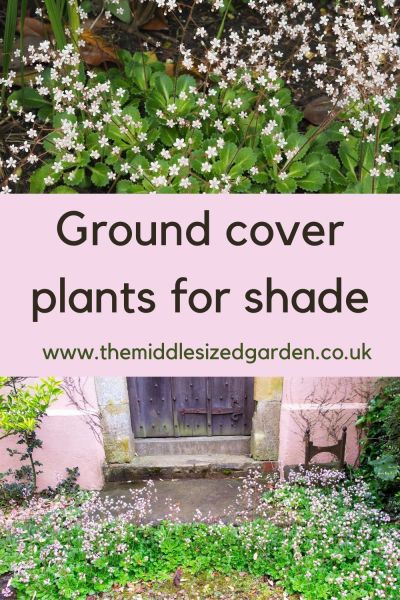
A delicately pretty ground cover plant – Saxifrage ‘London Pride’. It goes well with Geranium Macrorrhizum, which is another good plant for shade.
Another good ground cover perennial is Yellow Lamium, although some people find it invasive and considered it as a weed. It’s also known as Yellow Archangel or Yellow Weasel-face. Primroses, too, will happily thrive in some fairly gloomy spots.
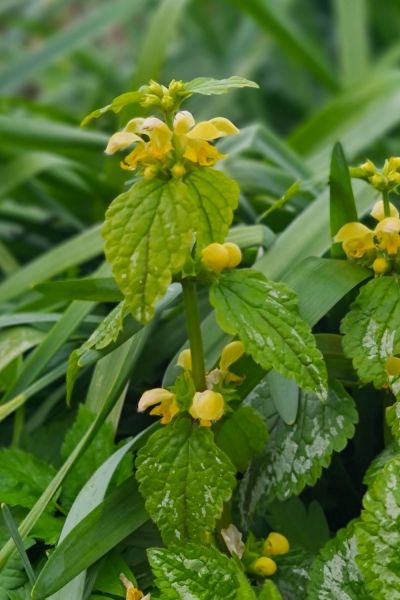
Yelllow Lamium will grow where almost nothing else will – although it can be invasive. Too much of a good thing?
Annuals, biennials and shrubs for shade
Euphorbia oblongata or spurge self-seeds itself in my shady border, and has bright, fresh green flowers and foliage throughout early spring and summer.
Perfoliate Alexanders (Smyrnium perfoliatum) looks quite similar but is more distinctive – every time I post a picture of it on my Instagram feed, I get queries as to what it is. Smyrnium perfoliatum is a biennial and it self-seeds vigorously. I have it in the dappled shade border and also the seasonal shade border.
For ground cover, violas are good shade-loving annuals, which self-seed vigorously.
One of my favourite shade-loving shrubs is Viburnum opulus or Snowball bush. It has white pom-pom flowers in spring and some varieties also have red berries. Mine doesn’t – it’s sterile, so check that on the label before you buy. But it does have magnificent autumn leaf colour.
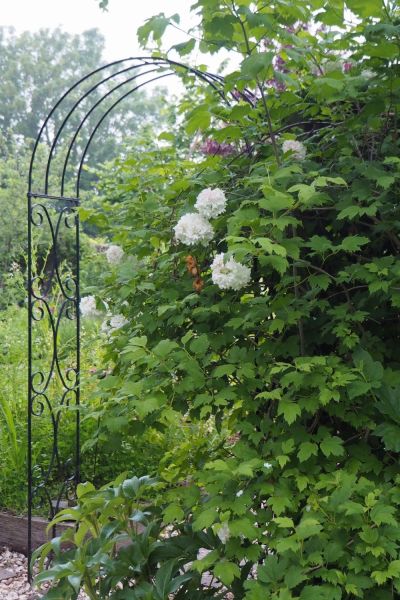
Viburnum opulus has beautiful white pom-poms in spring and gorgeous autumn colour.
I also like Osmanthus delavyi, which is a dark evergreen shrub which is flowering its socks off directly underneath the evergreen Magnolia Grandiflora. It’s very slow growing and has taken about ten years to get to that size but it’s definitely worth thinking about.
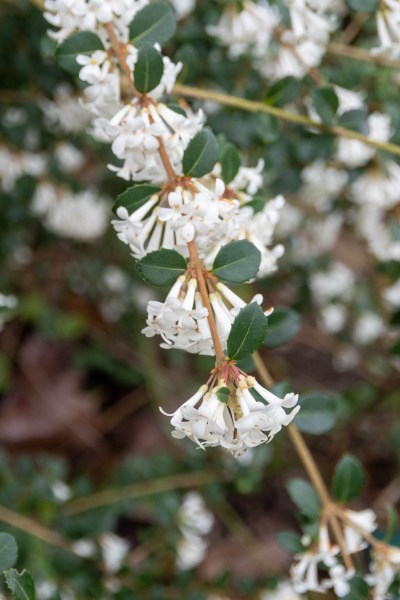
Osmanthus delavayi is a slow growing dark green shrub with beautiful white flowers. Mine has grown well in quite deep shade.
Colourful flowers for shade
Begonias are an amazing species. Like many really versatile plants, they can be overlooked because you can see them in supermarket car parks and in municipal arrangements. But you can buy a wide range of flower types and colours, and some also have wonderful leaf structure.
Begonias do well in pots and in borders in filtered light. They really do prefer to be in at least partial shade. They won’t flower in deep shade, but if there’s 3-4 sun a day, they’ll be happy and they’re fine in dappled shade.
And begonias start flowering fairly early on in the summer, depending on their type. And they go on and on and on.

Begonias (top) and Busy Lizzies. Begonias come in a huge range of colours and also have some dramatic foliage.
Impatiens, or Busy Lizzies, also grow well in similar conditions. They almost disappeared from the market a few years ago as they were affected by a disease, but disease resistant varieties are now available.
How to choose plants for dry shade
Dry shade is one of the most difficult areas of the garden to plant.
Once again, there will be the deepest dry shade under trees on a north-facing wall, where the shade will be almost absolute. Yet plants growing on a south-facing wall (in the northern hemisphere) will get some sun even if they’re shaded by trees or buildings.
Here is a post on how to choose the best plants for dry shade.
Good late summer and autumn plants for shade
Stephen and Matthew will tell you more about what you need to know in this video on their Horti-Culturalists channel:
Shop my favourite gardening books, tools and products
I’m often asked for recommendations, so I’ve put lists of the gardening books, tools and products I use on the Middlesized Garden Amazon Store. Note that links to Amazon are affiliate, see disclosure.
For example, there is a list of books on gardening in the shade and plants for shade.
Pin to remember plants for shade
And do join us – for a free weekly email with more gardening tips, ideas and inspiration, see here.
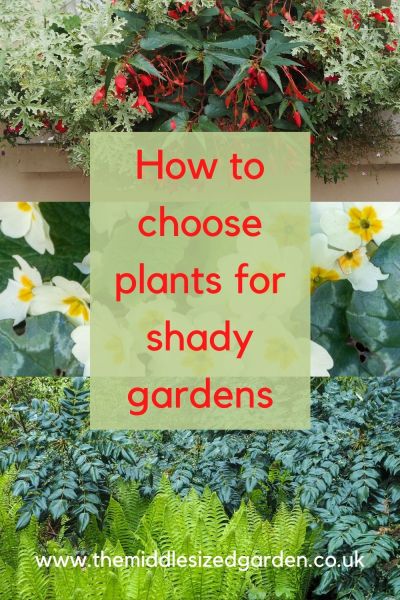
























Some good ideas. Personally I don’t think you can beat ferns.
Excellent suggestion!